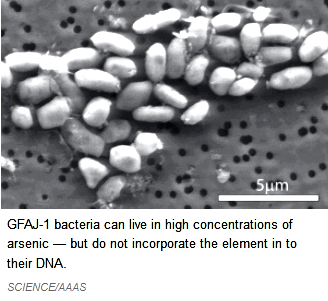|
News & Views item - July 2012 |
![]() Arsenous Highly-Tolerant Bacteria Do
Require Phosphorous. (July 10, 2012)
Arsenous Highly-Tolerant Bacteria Do
Require Phosphorous. (July 10, 2012)
It's taken 1½ years, but two papers in last week's Science Express have demonstrated that the Halomonadaceae bacterium GFAJ-1 cannot reproduce without phosphorous.
Marshall Louis Reaves, Sunita Sinha, Joshua D. Rabinowitz1, Leonid Kruglyak1 and
Rosemary J. Redfield report in their paper "Absence of Detectable Arsenate in
DNA from Arsenate-Grown GFAJ-1 Cells":
A strain of Halomonas bacteria, GFAJ-1, has been claimed to be able to use arsenate as a nutrient when phosphate is limiting, and to specifically incorporate arsenic into its DNA in place of phosphorus. However, we have found that arsenate does not contribute to growth of GFAJ-1 when phosphate is limiting and that DNA purified from cells grown with limiting phosphate and abundant arsenate does not exhibit the spontaneous hydrolysis expected of arsenate ester bonds. Furthermore, mass spectrometry showed that this DNA contains only trace amounts of free arsenate and no detectable covalently bound arsenate.
The second paper by Tobias J. Erb, Patrick Kiefer1, Bodo Hattendorf, Detlef Günther and Julia A. Vorholt in their paper "GFAJ-1 Is an Arsenate-Resistant, Phosphate-Dependent Organism" summarise their findings:
The bacterial isolate GFAJ-1 has recently been proposed to substitute arsenic for phosphorus to sustain growth. We have shown that GFAJ-1 is able to grow at low phosphate concentrations (1.7 μM), even in the presence of high concentrations of arsenate (40 mM), but lacked the ability to grow in phosphorus-depleted (<0.3 μM), arsenate-containing medium. High-resolution mass spectrometry analyses revealed that phosphorylated central metabolites and phosphorylated nucleic acids predominated. A few arsenylated compounds, including C6 sugar arsenates, were detected in extracts of GFAJ-1, when GFAJ-1 was incubated with AsO43-, but further experiments showed that they formed abiotically. Inductively coupled plasma mass spectrometry confirmed the presence of phosphorus and the absence of arsenic in nucleic acid extracts. Taken together, we conclude that GFAJ-1 is an arsenate-resistant, but still a phosphate-dependent bacterium.
In a statement, Science said: “The new research shows that GFAJ-1 does not break the long-held rules of life, contrary to how Wolfe-Simon had interpreted her group’s data,” while Felisa Wolfe-Simon, the senior author of the original paper in Science (Science 332, 1163–1166 (2011)), has responded:
The original GFAJ-1 paper emphasized tolerance to arsenic, but suggested the cells required phosphorus, as seen in these two new papers, However, our data implied that a very small amount of arsenate may be incorporated into cells and biomolecules, helping cells to survive in environments of high arsenate and very low phosphate. Such low amounts of arsenic incorporation may be challenging to find and unstable once cells are opened.... The key questions are: how do these cells thrive in lethal concentrations of arsenic? And where does the arsenic go?
In short Dr Wolfe-Simon has backed further away from the original NASA media hype suggesting that arsenate could replace phosphorus in Halomonadaceae nucleic acid.